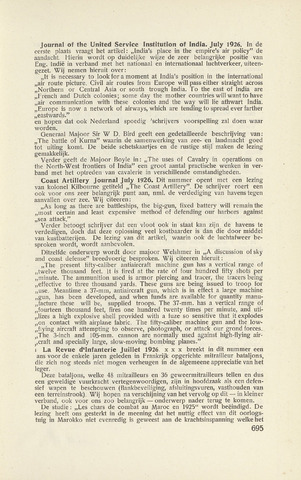695
Journal of the United Service Institution of India. July 1926. In de
eerste plaats vraagt het artikel„India's place in the empire's air policy" de
aandacht. Hierin wordt op duidelijke wijze de zeer belangrijke positie van
Eng. Indië in verband met het nationaal en internationaal luchtverkeer, uiteen
gezet. Wij nemen hieruit over:
„It is necessary to look for a moment at India's position in the international
„air route picture. Civil air routes from Europe will pass either straight across
„Northern or Central Asia or south trough India. To the east of India are
„French and Dutch colonies; some day the mother countries will want to have
„air communication with these colonies and the way will lie athwart India.
„Europe is now a network of airways, which are tending to spread ever farther
„eastwards."
en hopen dat ook Nederland spoedig 'schrijvers voorspelling zal doen waar
worden.
Generaal Majoor Sir W D. Bird geeft een gedetailleerde beschrijving van:
„The battle of Kurna" waarin de samenwerking van zee- en landmacht goed
tot uiting komt. De beide schetskaartjes en de rustige stijl maken de lezing
gemakkelijk.
Verder geeft de Majoor Boyle in: „The uses of Cavalry in operations on
the North-West frontiers of India" een groot aantal practische wenken in ver
band met het optreden van cavalerie in verschillende omstandigheden.
Coast Artillery Journal July 1926. Dit nummer opent met een lezing
van kolonel Kilbourne getiteld „The Coast Artillery". De schrijver roert een
ook voor ons zeer belangrijk punt aan, nml. de verdediging van havens tegen
aanvallen over zee. Wij citeeren:
„As long as there are battleships, the big-gun, fixed battery will remain the
„most certain and least expensive method of defending our harbors against
„sea attack."
Verder betoogt schrijver dat een vloot ook in staat kan zijn de havens te
verdedigen, doch dat deze oplossing veel kostbaarder is dan die door middel
van kustbatterijen. De lezing van dit artikel, waarin ook de luchtafweer be
sproken wordt, wordt aanbevolen.
Ditzelfde onderwerp wordt door majoor Welshmer in „A discussion of sky
and coast defense" breedvoerig besproken. Wij citeeren hieruit
„The present fifty-caliber antiaircraft machine gun has a vertical range of
„twelve thousand feet. It is fired at the rate of four hundred fifty shots per
„minute. The ammunition used is armor piercing and tracer, the tracers being
„effective to three thousand yards. These guns are being issued to troop for
„use. Meantime a 37-mm, antiaircraft gun, which is in effect a large machine
„gun, has been developed, and when funds are available for quantity manu
facture these will be, supplied troops. The 37-mm. has a vertical range of
„fourteen thousand feet, fires one hundred twenty times per minute, and uti
lizes a high explosive shell provided with a fuze so sensitive that it explodes
,,on contact with airplane fabric. The fifty-caliber machine gun and the low-
flying aircraft attempting to observe, photograph, or attack our grond forces.
,,The 3-inch and 105-mm. cannon are normally used against high-flying air
craft and specially large, slow-moving bombing planes."
i La Revue d'Infanterie Juillet 1926 x x x breekt in dit nummer een
ans voor de enkele jaren geleden in Frankrijk opgerichte mitrailleur bataljons,
die zich nog steeds niet mogen verheugen in de algemeene appreciatie van het
leger.
Deze bataljons, welke 48 mitrailleurs en 36 geweermitrailleurs tellen en dus
een geweldige vuurkracht vertegenwoordigen, zijn in hoofdzaak als een defen
sief wapen te beschouwen (flankbeveiliging, afsluitingsvuren, vasthouden van
een terreinstrook). Wij hopen na verschijning van het vervolg op dit in kleiner
verband, ook voor ons zoo belangrijk onderwerp nader terug te komen.
De studie: „Les chars de combat au Maroc en 1925" wordt beëindigd. De
lezing heeft ons gesterkt in de meening dat het nuttig effect van dit oorlogs
tuig in Marokko niet evenredig is geweest aan de krachtsinspanning welke het

